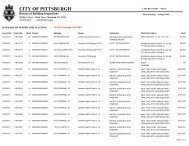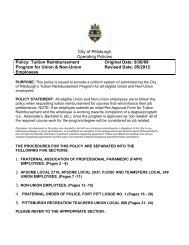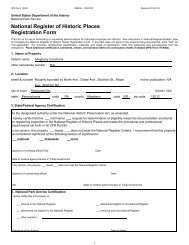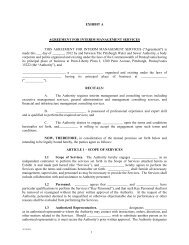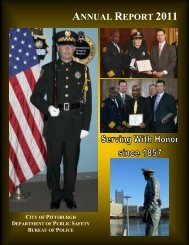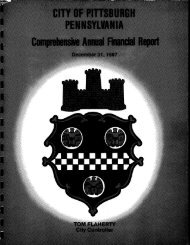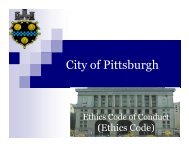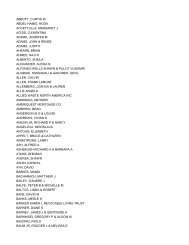east liberty station: realizing the potential - City of Pittsburgh
east liberty station: realizing the potential - City of Pittsburgh
east liberty station: realizing the potential - City of Pittsburgh
You also want an ePaper? Increase the reach of your titles
YUMPU automatically turns print PDFs into web optimized ePapers that Google loves.
4<br />
EXECUTIVE SUMMARY<br />
The <strong>City</strong> <strong>of</strong> <strong>Pittsburgh</strong> neighborhood<br />
<strong>of</strong> East Liberty was <strong>the</strong> third largest<br />
commercial district in <strong>the</strong> state <strong>of</strong><br />
Pennsylvania in <strong>the</strong> 1950’s with more than<br />
500 local businesses and a population<br />
<strong>of</strong> 14,000. As <strong>the</strong> automobile became<br />
<strong>the</strong> dominant mode <strong>of</strong> transportation,<br />
congestion increased. Residential and<br />
commercial shifts to <strong>the</strong> ‘car-friendly’<br />
suburbs in <strong>the</strong> following decades resulted<br />
in disastrous social and economic downturn<br />
that destroyed <strong>the</strong> urban fabric.<br />
Urban renewal schemes were devised<br />
to stop <strong>the</strong> flight. Penn Avenue was<br />
reconstructed as car friendly loop around<br />
<strong>the</strong> neighborhood with vast surface parking<br />
lots for a “mall” atmosphere in an effort to<br />
compete with suburban retail experience.<br />
When building this “circle”, many small<br />
businesses were closed and torn down.<br />
Development oriented to <strong>the</strong> use <strong>of</strong> <strong>the</strong><br />
automobile came at <strong>the</strong> expense <strong>of</strong> mass<br />
transit and pedestrian activity.<br />
Three large housing complexes were<br />
constructed to make up for <strong>the</strong> destruction <strong>of</strong><br />
<strong>the</strong> homes that were removed when creating<br />
Penn Circle. Though well intentioned, both<br />
contributed heavily to <strong>the</strong> decline <strong>of</strong> <strong>the</strong><br />
once vibrant community. For decades, East<br />
Liberty was characterized by thousands <strong>of</strong><br />
mostly vacant high rise housing units flanking<br />
a decaying business district. The areas<br />
lost more than one million square feet <strong>of</strong><br />
commercial space and half its population by<br />
1980. Blight spread and crime rates soared.<br />
East Liberty is now experiencing a longdelayed<br />
rebirth as a commercial hub that<br />
will be centered around direct access to <strong>the</strong><br />
Port Authority <strong>of</strong> Allegheny County (PAAC)<br />
Bus Rapid Transit (BRT) Corridor (known as<br />
<strong>the</strong> Martin Lu<strong>the</strong>r King, Jr. East Busway).<br />
To be successful in <strong>the</strong> 21st century and<br />
capitalize on redevelopment opportunities,<br />
<strong>the</strong> area requires a more robust pedestrian,<br />
bike and mass transit infrastructure. This<br />
strategy for reviving historical urban<br />
commercial districts through multimodal<br />
improvements can be a model not only for<br />
<strong>Pittsburgh</strong>, but for communities throughout<br />
Pennsylvania.<br />
East Liberty Station and <strong>the</strong> surrounding district today<br />
East Liberty is uniquely positioned to<br />
leverage <strong>the</strong> PAAC transit network,<br />
especially <strong>the</strong> East Busway. Through a<br />
partnership with <strong>the</strong> PAAC, Southwestern<br />
Pennsylvania Commission (SPC), Allegheny<br />
County, <strong>Pittsburgh</strong> Public School<br />
District, Urban Redevelopment Authority<br />
(URA), East Liberty Development Inc.<br />
(ELDI), various community development<br />
organizations and <strong>the</strong> private development<br />
community, <strong>the</strong> <strong>City</strong> <strong>of</strong> <strong>Pittsburgh</strong> is<br />
collaboratively building a sustainable<br />
strategy to continue revitalization <strong>of</strong> this<br />
transition neighborhood. Coordination <strong>of</strong><br />
transportation and land use through <strong>the</strong><br />
East Liberty TRID Study | <strong>Pittsburgh</strong> Department <strong>of</strong> <strong>City</strong> Planning



